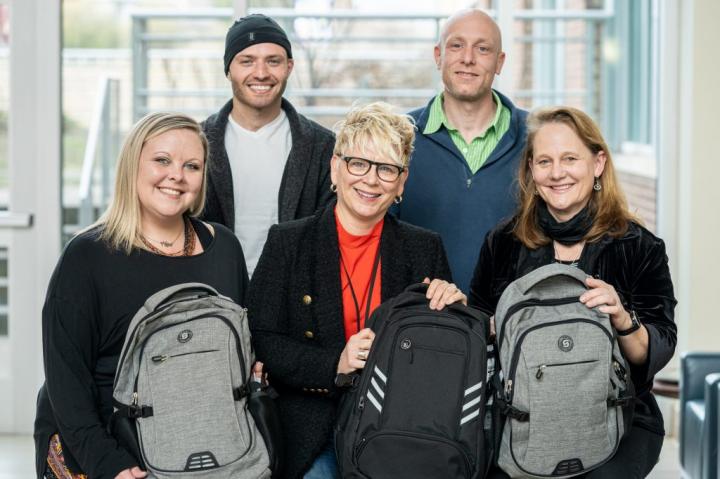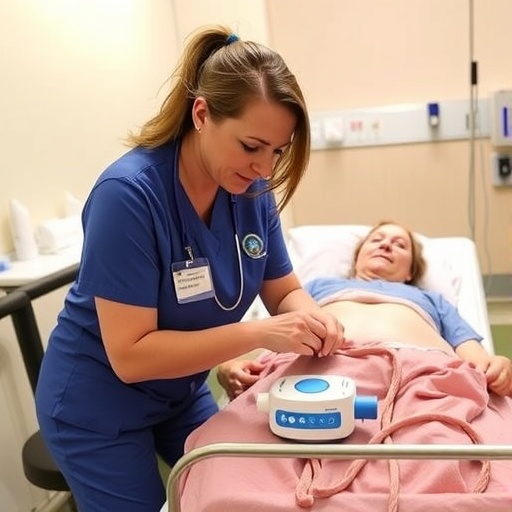
Credit: Clayton Metz for Virginia Tech
Keep people alive. Refer them to those who save lives. Finally, connect them to effective, peer-based treatment. These are the objectives of Connection 2 Care (C2C), an innovative collaboration led by Virginia Tech researchers that aims to address the opioid crisis in the Roanoke Valley.
Through community partnerships and grassroots engagement efforts, C2C plans to facilitate peer-to-peer counseling and distribute backpack kits containing life-saving resources to those most at risk of opioid overdoses.
In support of these initiatives, C2C recently received a competitive grant of almost $300,000 through the Combating Opioid Overdose Through Community-level Intervention initiative. Funded by the National Office of Drug Control Policy, the program is managed by the University of Baltimore’s Center for Drug Policy and Enforcement.
Co-principal investigators Mary Beth Dunkenberger and Kimberly Horn of Virginia Tech lead the project. Dunkenberger is the associate director of the Institute for Policy and Governance (IPG) in the School for Public and International Affairs. Horn, a scientist and research professor with the Fralin Biomedical Research Institute at Virginia Tech Carilion, is the founding co-chair of the Roanoke Valley Collective Response, along with Bradley Free Clinic Executive Director Janine Underwood.
A seed grant from the university’s Vibrant Virginia program helped propel the C2C concept. This initial funding fostered a partnership with the Roanoke Valley Collective Response.
The Roanoke Valley Collective Response to the Opioid Addiction Crisis was launched in September 2018. It includes 250 stakeholders across the Roanoke area and represents 120 organizations, including law enforcement, emergency responders, business leaders, public health experts, and those within the area’s medical infrastructure.
Much of its work is accomplished through five thematic working groups: prevention, treatment, crisis response, recovery, and child and family support services. The C2C grant funds strategies developed through the third working group, crisis response.
“The seed grant fostered engagement with and support for the work of the Collective Response through policy analysis and identification of gaps in substance use disorder services and resources,” said Dunkenberger.
And the community has been hit hard. The Roanoke Metropolitan Statistical Area was designated a High Impact Drug Trafficking Area by the White House Office on National Drug Control Policy. It is also recognized as a “Comprehensive Harm Reduction Locality” by the Virginia Department of Health.
Grant collaborators stress that addressing what factors spurred the crisis in the Roanoke Valley will be key to its success.
Using previous research, the crisis response group identified three touchpoints where individuals are most at risk of dying from an overdose: they are in active drug use, they are re-entering the community after incarceration, or they have recently left a residential treatment program.
The grant funds crisis response where direct human contact at these touchpoints will be possible. Key partners in that fight are the HOPE Initiative, Bradley Free Clinic, and the Virginia Harm Reduction Coalition (VHRC). Both HOPE and the VHRC will provide peer counselors who understand the lived experience and challenges of at-risk individuals and can recognize when they are most motivated to pursue recovery and treatment.
Carilion Clinic Emergency Department, Roanoke City EMS, and Western Regional Jail will also distribute 300 C2C assistive backpack kits when direct contact occurs. Dunkenberger noted that the backpacks are a way to physically connect with a vulnerable, hard-to-reach population. In addition to providing life-saving medication at the most crucial point — 70 percent of overdoses are reversed by a peer who is present — she said the backpacks communicate a crucial message to the recipient: “We want you to survive, and we want to connect you to services.”
Prototypes of the backpacks, stocked with Naloxone, basic living supplies, and durable referral information cards, were produced by College of Architecture and Urban Studies students with guidance by industrial design program chair Akshay Sharma and Assistant Professor Elham Morshedzadeh. Designed particularly for at-risk individuals who are housing insecure, the grant will also support backpack distribution by peer recovery specialists.
Although the project team will initially rely on standard off-the-shelf backpacks, C2C hopes to obtain additional funding to manufacture and broadly field test the prototypes. Ultimately, researchers will evaluate the success of this particular intervention in saving lives.
“Connection 2 Care is a stellar example of what can happen as a result of people getting out of their silos and working together in innovative ways,” said Horn. “We hope this pilot study will give us information that can be used to increase referrals for people at risk and achieve harm reduction, at a minimum. It may also inform area-wide infrastructure changes that improve the often fragmented pathways to treatment.”
Dunkenberger also noted the grant’s focus on long-term success strategies and the creation of sustainable processes. “We hope the C2C pilot will establish an enduring way to connect those most at risk of overdose to harm reduction and treatment services,” she said. “Coupling the applied intervention with robust outcome and process evaluation enables sustainability and ongoing innovation.”
In addition to Horn’s contribution as the lead evaluator, the Center for Public Health Practice and Research, housed in the Department of Population Health Sciences within the Virginia-Maryland College of Veterinary Medicine, is also represented by Director Kathy Hosig and Associate Director Sophie Wenzel, both of whom also serve as co-principal investigators on the project. Other university partners include the Center for Biostatistics and Health Data Science in the College of Science, represented by director Alexandra Hanlon.
Media Contact
Emily Roediger
@vtnews
540-231-2108
Original Source
https:/




